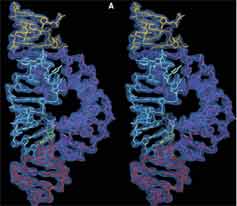

Wednesday - August 16, 2006
SLAC Today is
available online at:
http://today.slac.stanford.edu
In this issue:
Beautiful Images Yield Insights into the Origins of Life
Profile Today: Katherine George
Photo of the Day: SULI Summer Students Enjoy Last Week at Lab
Global Climate and Energy Symposium
 |
 |
|
Wednesday - August 16, 2006 |
Beautiful Images Yield Insights into the Origins of Life
Diagrams of the Full-Length Hammerhead Ribozyme Scientists at the University of California-Santa Cruz came to the Stanford Synchrotron Radiation Laboratory and the Advanced Light Source to take images of ribozymes—molecules that offer glimpses into how life may have originated. Ribozymes are made of the genetic material RNA, and they act as chemical catalysts, like protein enzymes. Ribozymes would have enabled the first self-replicating molecules, also made of RNA, to copy themselves. Using macromolecular x-ray crystallography, the researchers obtained a three-dimensional picture of the spatial arrangement of the several thousand atoms that comprise a very simple ribozyme. After seeing how the molecule can mediate catalysis, the researchers proposed that ribozyme chemistry predates the origin of protein enzymes, which are now needed to replicate genes. The new findings are described by graduate student Monika Martick and her advisor, William Scott, in the July 27 issue of the journal Cell. "Monika e-mailed me from the Stanford Synchrotron at 3 a.m. to show me the most beautiful electron density map I had ever seen," Scott said. "I was so amazed I probably didn't sleep for the next three weeks." Many academic and industrial laboratories are engineering ribozymes for potential use in fighting infectious and chronic diseases. |
||
|
|
||
 Katherine George
"I had to present six new results in ten minutes, when I could have easily spent half an hour on a single result," she says. George had to not only fit in all the new results of her and her colleagues' work, but convey the findings—and their importance—in a manner that all audience members, be they experimentalists or theorists, could understand. "ICHEP is a showcase for reporting what BaBar has done, we have to be coherent," she says. To balance the salient information with coherence, George devoted more than a week to preparing, mostly reading collaborators' conference notes and copious supporting documentation. "You're publicizing other people's work as well," she says. "Your biggest fear as a speaker is to get a question starting with 'I see on slide four, the third bullet point mentions...' You hope you're prepared enough to represent others' analyses. It's not that it could be curtains, but you have to think on your feet." The results George presented are collaborative—some 20 to 30 people contributed to the analyses presented in her talk. At the rehearsal talk, collaborators suggested aspects to emphasize, offered questions that audience members might ask, and came back with updated figures as the results were finalized. In the end, George managed to pack the latest results for one of BaBar's flagship analyses: the measurement of sin2β—its angle is now refined to within one degree—along with updates in the search for a violation of charge-parity-time symmetry into the allotted ten minutes. George's ICHEP experience came just as she's finishing her two years at SLAC as a postdoc from the University of Liverpool. She has also worked as a BaBar run coordinator since May, allowing her to experience all aspects of working on a running experiment—from overseeing the taking of data at BaBar, analyzing that data and then presenting the results at ICHEP. "It's the best talk I could have given at this stage of my career," she says. |
Photo of the Day:
|
Events (see all | submit)
Access (see all)
Announcements
|
| | ||
|
|
||
 <%
Response.AddHeader "Last-modified", getArticleDate()
'Response.AddHeader "Last-modified","Mon, 01 Sep 1997 01:03:33 GMT"
'Monday, December 06, 2010
%>
<%
Response.AddHeader "Last-modified", getArticleDate()
'Response.AddHeader "Last-modified","Mon, 01 Sep 1997 01:03:33 GMT"
'Monday, December 06, 2010
%>View online at http://today.slac.stanford.edu/. |
||